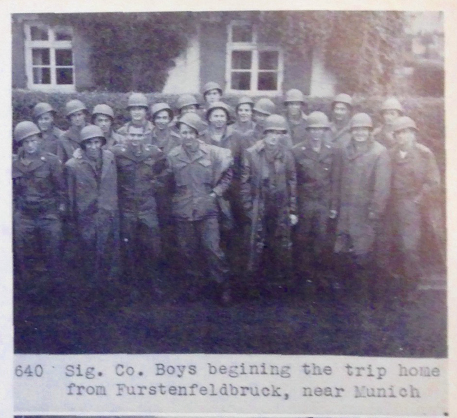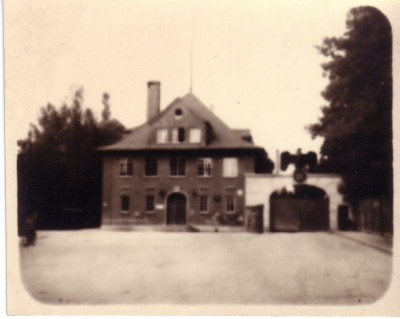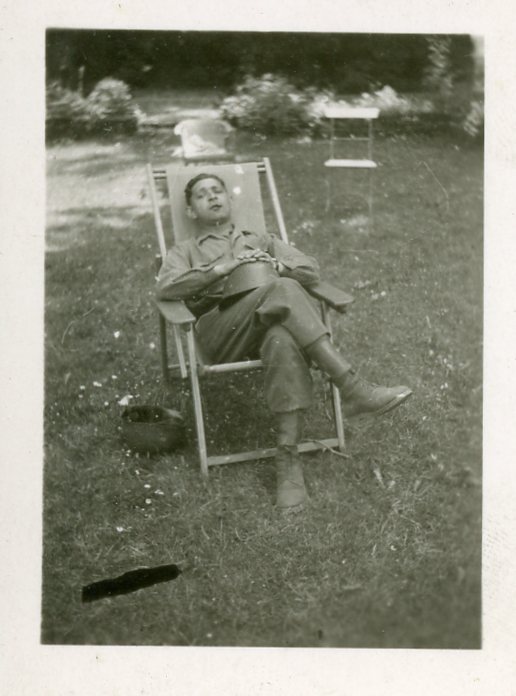 45th Signal Company
45th Signal Company
LEFT: 45th Signal Company
Distinctive unit insignia
Communications
Support for the 45th Infantry Divison During the Liberation of
Dachau
 Click on photo for larger format
Some
members of the 45th Signal Company
after the liberation of Dachau on occupation duty 16
miles away
at Furstenfeldbruck, Germany
Click on photo for larger format
Some
members of the 45th Signal Company
after the liberation of Dachau on occupation duty 16
miles away
at Furstenfeldbruck, Germany
The
45th Infantry Division combat units of Task Force Spark that were the co-liberators
Dachau were supported by the service and support units of
the 45th Infantry Division including the 45th Signal Company
On the day of liberation, April
29th, 1945 the 45th Signal Company was moving from
Schrobenhausen about 39 miles (63 kilometers) by road north of
Dachau to Haimhausen, about 8 miles (13 kilometers) by road
northeast of Dachau.
Click on map for larger format
.
Map showing possible routes of
the 45th Signal Company from Schrobenhausen, northwest of
Dachau to
Haimhausen, northeast of Dachau on April 29,
1945.
The 45th Signal Company provided lateral communications support
among the 45th ID's units.
After Liberation: The Battle of
Munich
On April 30th, the day after
liberation, the 45th Signal Company moved to Feldmoching, Munich,
about 7 1/2 miles (12 kilometers) by road southeast of Dachau.
Photos and
Newspaper
- The 45th
Signal Company Photo Album
In the The 45th Signal Company
Photo Album
compiled and edited by Thomas R. McLeon of photos taken by Thomas
R. McLeon, A.P. Clark, Gene Simonson, Frank Jardieu, William R.
Potts, and Bill Smith.
Click on image for PDF
with three pages from the The 45th Signal
Company Photo Album with the eight Dachau photo

The caption on the photo of the crematorium erroneously
states that it also included a gas chamber.
Dachau was a concentration
camp but not an extermination camp.
Postwar research found that those gas chambers may have been part
of the SS poison gas research that was done in the camps.
Some inmates were killed in those gas chambers as part of those
experiments.
Estimated 32,000 people murdered by the Nazis at Dachau were
killed by other means such as firearms, hanging, beating, along
with overwork, starvation, and medical neglect.
Felix A. Cizewski kept his copy of the Dachau liberation edtion of the
45th Division News.
Felix A. Cizewski found a photo of the the
entrance to an SS training camp and garrison for Waffen-SS
soldiers, located west of the concetration camp.
Click on image for larger
format

Care for the
Liberated Inmates While on Occupation Duty of
Germany
The 45tth Signal Comapny was stationed
on occupation duty at Furstenfeldbruck 16 miles southwest of the
Dachau concentration camp from May until late July 15, 1945.
Click on map for larger format

"Immediately after Dachau's liberation, U.S.
Army authorities and other Allied representatives began
treating the sick prisoners, implementing health and
sanitary measures to curb the typhus epidemic, and
bringing in tons of food to feed the starving
prisoners." - U.S. Holocaust Memorial Museum
Dachau became a center for the processing of both the
32,000 liberated main camp inmates and the inmates from
the Dachau satellite network of 127 subcamps.
Very little
documentation has been found with details of the
care provided by members of the 45th to the
liberated Dachau main and subcamp inmates.
What is known
is that:
Soldiers
of the 45th organized convoys to returned liberated
main and subcamps to their homes.
Soldiers who could speak a language spoken
the many languages of the liberated inmates used those
skills to assist in the care of the liberated inmates.
What is unknown is if
any members of the 45th Signal Company were
among those who assisted in the care
For example, at least 9,000 of the 32,000 liberated main
camp inmates were Slavic Poles, 45th Signal Company
member Felix A. Cizewski was Polish speaker.
As he nver spoke of his experiences at Dachau, we do not
know if he translated for the Polish speaking liberated
inmates.
How Serving at
Concentration Camps Affected GIs
On June 5, 2009, as part of the
observances of the 65th
anniversary of D-Day, President Obama visited the concentration camp
at Buchenwald,
Germany.
His
remarks about his great-uncle may also
describe how Felix was effected by what he witnessed at
Dachau:
I've known about this place since I
was a boy, hearing stories about my great uncle, who was a very
young man serving in World War II. He was part of the 89th
Infantry Division, the first Americans to reach a concentration
camp. They liberated Ohrdruf, one of Buchenwald's
sub-camps.
And I told this story, he
returned from his service in a state of shock saying little and
isolating himself for months on end from family and friends,
alone with the painful memories that would not leave his
head. And as we see -- as we saw some of the images here,
it's understandable that someone who witnessed what had taken
place here would be in a state of shock.
For the rest of his life 45th Signal
Company veteran Felix A. Cizewski suffered from what may possibly
have some form of depression.
He may have been suffering from depression from before his WWII
service.
But might the trauma of what he experienced at Dachau worsened and
deepened his depression?
Personal Note:
Felix A. Cizewski was my late father.
He was born on April 8, 1918 and had turned 27 three weeks before
arriving at Dachau.

Felix
A. Cizewski lounging with a captured Nazi helmet in Englischer Garten in Munich
Sources:
In
The
Liberator, Alex Kershaw reports 9,082 of the surviving
inmates were Slavic Polish. He does not specify the
citizenship of the 2, 539 surviving Jewish inmates some of
whom were also Polish citizens.
In
Forgotten Holocaust:
The Poles Under German Occupation 1939-1944 author Richard C. Lukas reports
as many as 8,900 Poles among the liberated survivors of
Dachau.
Lukas sites as his source: Jan Domagala, Ci Ktorzy Przeszli Przeszli
Przez Dachau (Duchowni w Dachau).
Warsaw: Pax, 1957
United
States Holocaust Memorial Museum, Holocaust Encyclopedia's entry
The 45th Infantry Division.
 45th Signal Company
45th Signal Company
 45th Signal Company
45th Signal Company






 2021 Leonard
H. Cizewski
2021 Leonard
H. Cizewski Illinois
Holocaust Museum and Education Center
Illinois
Holocaust Museum and Education Center